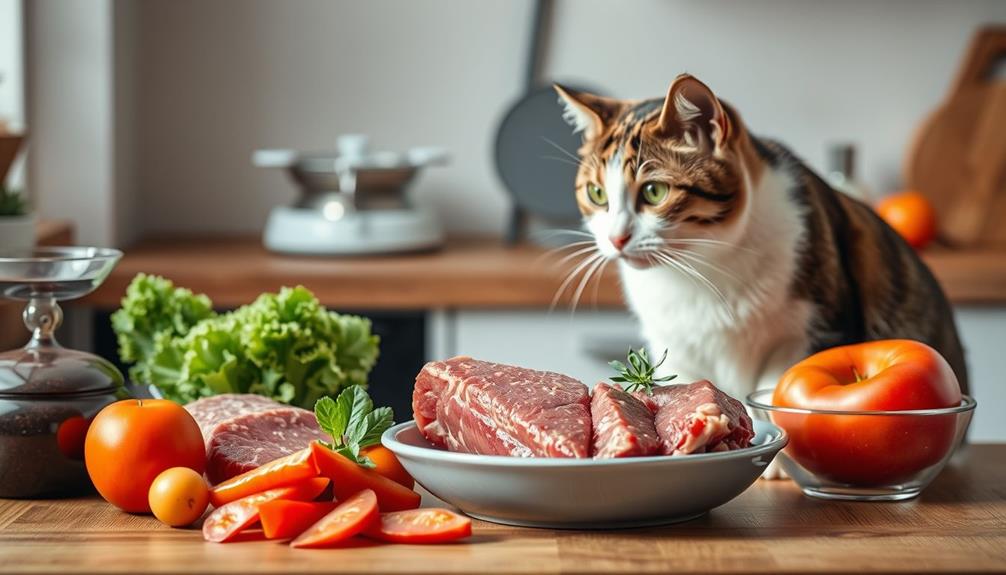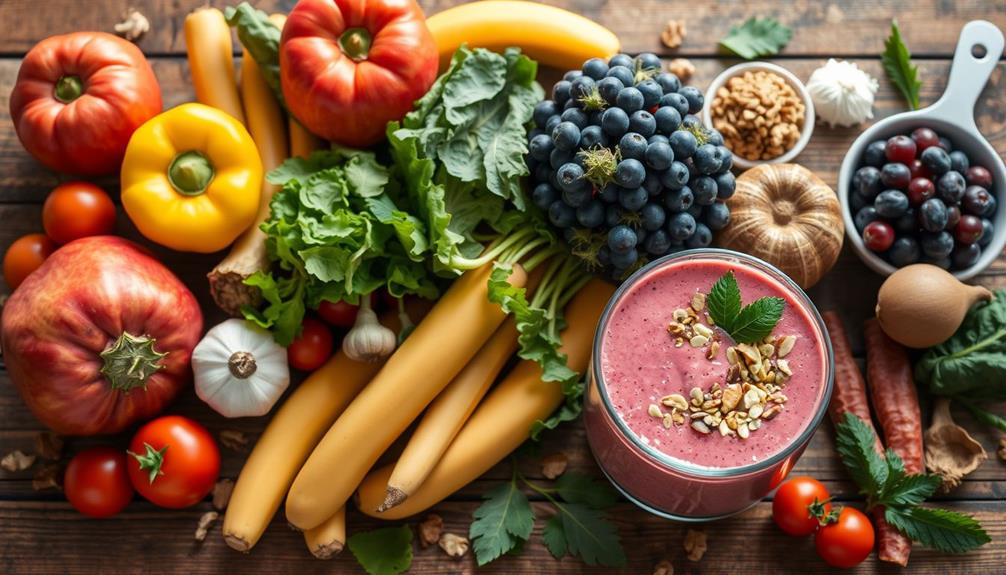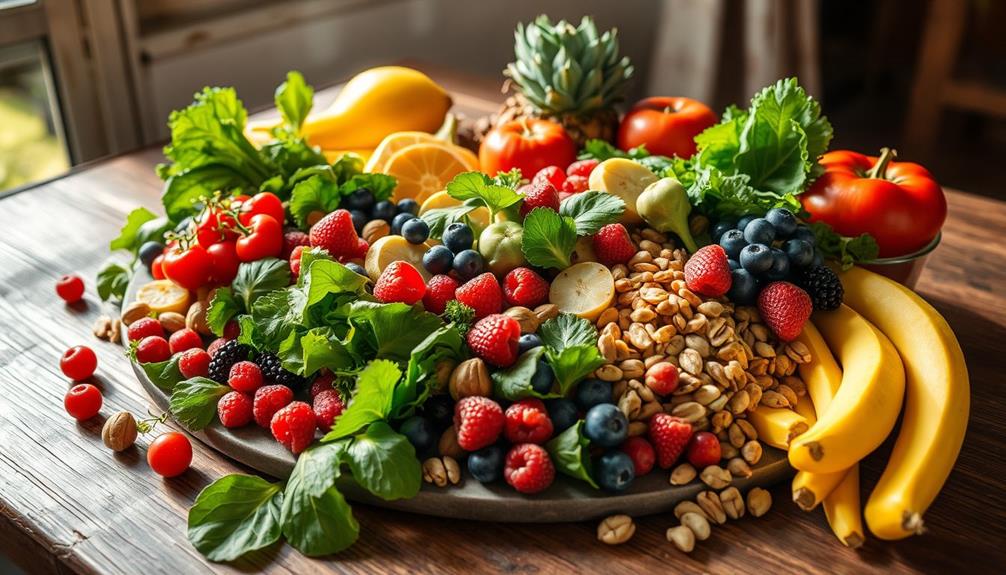To determine how much raw food to feed your cat, start with their ideal body weight. For adult cats, aim for 2-3% of their weight daily—in grams, that's about 80 to 120 grams for a 4 kg cat. Less active cats might need around 60 grams, while highly active ones could require closer to 120 grams. For kittens, the amount varies considerably; they need 10-13% of their body weight initially, decreasing to 3-6% by their first year. Monitoring their weight will help adjust portions. Learn how to shift smoothly to a raw diet and guarantee peak nutrition. When transitioning your cat to a raw food diet, it’s important to start slowly and gradually introduce new foods to avoid stomach upset. Always ensure that the raw food you are feeding your cat is safe and appropriate for their dietary needs. Safe raw food for cats includes high-quality meat, organs, and bones, as well as supplements to provide essential nutrients. Consulting with a veterinarian or pet nutritionist can help ensure that your cat is getting the right balance of nutrients in their raw diet. When considering raw food options for cats, it’s important to provide a variety of proteins such as chicken, turkey, beef, and fish to ensure they receive a well-rounded diet. Additionally, including small amounts of fruits and vegetables can offer added vitamins and minerals. Some cats may benefit from a commercially prepared raw food diet, while others may thrive on a homemade raw diet. It’s essential to monitor your cat’s health and make adjustments to their raw food diet as needed to ensure they are receiving the proper nutrition.
Key Takeaways
- Adult cats should receive 2%-3% of their ideal body weight in raw food daily, translating to 80-120 grams for a 4 kg cat.
- Kittens aged 2-3 months need 10%-13% of body weight in raw food, decreasing to 3%-6% by 8-12 months.
- Kittens should have daily portions divided into 2-3 smaller meals, ideally 4 meals a day.
- Weight monitoring is essential; stable weight indicates proper feeding, while excessive gain or loss signals adjustments are needed.
- Larger or more active breeds may require more food, while less active cats need less to maintain a healthy weight.
Nutritional Requirements for Cats
When it comes to feeding your cat, understanding their nutritional requirements is essential. As obligate carnivores, cats thrive on a meat-based diet that comprises at least 90% raw food. This high-quality protein is vital for meeting their nutritional needs. A raw food diet can also enhance nutrient absorption due to minimal processing, leading to better overall health.
For kittens, you'll want to offer about 10% of their body weight in raw food daily, while adult cats generally require around 2%-3% of their ideal body weight.
A balanced raw diet should include muscle meat, organ meat, and bone, ensuring your feline friend receives all the essential nutrients to maintain good health. Not only does a raw food diet promote better nutrient absorption, but it also leads to less waste production and healthier digestion, making it a sustainable choice for pet owners benefits of raw food.
To optimize your cat's health, regularly monitor their weight, as dietary needs can vary based on age, activity level, and breed type. Keeping an eye on these factors will help you adjust their food intake according to your feeding guide.
Feeding Guidelines for Kittens

When it comes to feeding your kitten, understanding their daily food needs is essential for their growth and health.
Developmental milestones during their early stages, such as emotional and psychological growth, play a significant role in their overall well-being.
You'll want to adjust portions as they grow, and splitting their meals into smaller servings is key to meeting their energy requirements.
Let's explore the specific guidelines to guarantee your kitten thrives during these important developmental stages.
Kittens' Daily Food Needs
Kittens have unique daily food needs that change as they grow. For kittens aged 2-3 months, you should aim to feed them about 10%-13% of their body weight in raw food daily. This amount supports their rapid growth and high energy levels.
As you guarantee their diet is balanced, consider incorporating safe snacks in moderation, such as safe snacks for hamsters.
As your kittens reach 4-8 months, their daily food requirement decreases to 6%-10% of their body weight, reflecting a more steady growth phase. By 8-12 months, you'll want to adjust their intake to around 3%-6% of their body weight, which aligns with their maturation.
It's important to divide their daily food portions into at least 2-3 smaller meals. Kittens have smaller stomachs, so a consistent feeding schedule helps accommodate their frequent energy needs.
Regular weight checks are essential to guarantee you're providing the right amount of raw food without overfeeding. This way, you can monitor their growth and adjust portions as necessary.
Keeping track of their body weight will help you provide the best nutrition for your kittens and support their health and development as they grow into adulthood.
Feeding Frequency Recommendations
Feeding frequency plays an essential role in guaranteeing your kitten receives the right nutrition for their growth and energy needs. Ideally, you should feed your kitten 4 meals a day, with each meal spaced no more than 6 hours apart. This meal frequency helps maintain consistent energy levels throughout the day, critical for their development.
It's important to select the right type of food, as common types of cold medications can also impact overall health, including that of pets.
For kittens aged 2-3 months, aim for approximately 10%-13% of their body weight in raw food daily, divided into those smaller meals. As they grow, this percentage will decrease: from 4-8 months, feed them about 6%-10% of their body weight. By the time they reach 8-12 months, they'll need about 3%-6% of their body weight in food each day.
Regularly checking their weight is essential to adjust feeding amounts as their nutritional needs change.
Adjusting Portions for Growth
Making certain your kitten receives the right portion sizes is vital for their growth and overall health. When you're figuring out how much raw food to feed, consider their age and body weight. Kittens aged 2-3 months need about 10%-13% of their body weight in raw food daily to support their rapid growth and high energy levels.
As they grow to 4-8 months, you should adjust their portions down to 6%-10% of their body weight, reflecting their changing nutritional needs. It's important to understand how financial considerations for elderly care can impact pet ownership, as budgeting for pet food is a key part of responsible care.
By the time your kitten reaches 8-14 months, feeding raw food should stabilize at around 3%-6% of their body weight daily. To help with digestion and sustain energy levels throughout the day, divide their total daily food into at least 2-3 smaller meals.
Regular weight checks are significant. They help you monitor growth patterns and make sure you're adjusting portions appropriately. If you notice any significant changes in their weight or energy levels, don't hesitate to tweak their food intake. Maintaining the right balance is key for your kitten's healthy development.
Adult Cat Feeding Recommendations

When it comes to feeding your adult cat, it's vital to provide the right amount of raw food to maintain their health. Adult cats should generally receive about 2% to 3% of their ideal body weight in raw food daily. This means if your cat weighs 4 kg, you'd need to feed them around 80 to 120 grams of raw food each day.
Here's a simple breakdown to help you determine the right amount of food based on your cat's activity level:
| Activity Level | Food Percentage | Grams for 4 kg Cat |
|---|---|---|
| Less Active/Overweight | 1.5% | 60 grams |
| Average Activity | 2% | 80 grams |
| Active | 2.5% | 100 grams |
| Very Active/Underweight | 3% | 120 grams |
| Weight Maintenance | Adjust as needed | Varies |
Regularly monitoring your cat's weight is important. Adjust portions as their activity levels and overall health change. By doing this, you'll help guarantee your adult cat stays at a healthy weight and enjoys a balanced diet.
Factors Influencing Food Amounts

When it comes to feeding your cat, several factors play a vital role in determining the right amount. Your cat's age, activity level, and breed-specific needs can all affect their food requirements.
Understanding your cat's emotional well-being is also important, as stress and anxiety can impact their appetite and eating habits. Additionally, it's important to take into account the potential for co-occurring mental health issues that may affect their overall behavior.
Keeping an eye on their weight is crucial for adjusting portions and ensuring their overall health.
Age and Activity Level
Understanding how age and activity level impact your cat's dietary needs is crucial for their health and well-being. Each stage of life demands different amounts of raw food to guarantee your feline friend gets the energy they need.
Here's a simple breakdown:
| Age Group | Activity Level | Daily Food Requirement (of Body Weight) |
|---|---|---|
| Kittens (2-3 months) | Growing & Energetic | 10%-13% |
| Kittens (4-8 months) | Moderately Active | 6%-10% |
| Adult Cats | Varies (Active/Inactive) | 2%-3% (or 1.5% for less active) |
For active or underweight cats, aim for around 3% of their body weight daily to meet their higher energy demands. In contrast, senior or less active cats may only require about 1.5%. It's crucial to adjust these percentages according to your cat's activity level, guaranteeing they receive the proper nutrition based on their age and lifestyle. By paying attention to these factors, you'll help maintain their health and vigor throughout their life.
Breed-Specific Needs
Certain cat breeds have unique dietary requirements that can greatly influence how much raw food you should provide. Understanding these breed differences is vital for maintaining your cat's ideal weight and overall health.
For example, nutritional benefits can vary greatly between different breeds, making it important to take into account their specific needs when determining food amounts.
- Larger breeds like Maine Coons and Savannahs need more food due to their greater muscle mass and energy levels.
- Hairless breeds such as Sphynx require around 5-6% of their body weight daily to meet their higher caloric needs.
- Activity levels matter; active breeds may need extra food to support their energetic lifestyles.
- Growth rates vary; slow-growing breeds should follow general feeding guidelines while adjusting for their unique development pace.
Regular monitoring of your cat's body condition is essential to tailor feeding amounts appropriately.
You'll want to adjust the raw diet based on their specific breed characteristics and lifestyle. This will help guarantee they remain healthy, active, and at their ideal weight.
Weight Monitoring Importance
Monitoring your cat's weight is essential for guaranteeing they receive the right amount of raw food tailored to their needs. Regular weight monitoring helps you adjust their food intake accurately, as adult cats typically require 2%-3% of their ideal body weight in food daily.
For kittens, you'll need to check their weight frequently; they require 8%-10% of their body weight initially, decreasing to 4%-8% by five months. Additionally, understanding your cat's budgeting for pet care can help you manage costs associated with their diet effectively.
Changes in your cat's activity level can considerably impact their food needs. If your cat becomes more active, they may require a bit more raw food. Conversely, if they're less active, you'll want to reduce their portions.
Neutering is another factor to take into account, as it can lead to a reduced metabolism, necessitating lower food amounts to prevent obesity and maintain a healthy weight.
Lastly, don't forget seasonal variations can influence your cat's appetite and food consumption. By consistently monitoring their weight and adjusting their feeding amounts accordingly, you can guarantee your furry friend stays healthy and happy.
Signs of Proper Feeding Amount

When determining the right amount of raw food to feed your cat, look for key signs that indicate you're on the right track. A proper feeding amount guarantees your feline friend remains healthy and maintains their ideal body weight.
Additionally, consider incorporating essential oils such as eucalyptus oil for promoting respiratory health, which can be beneficial for your cat's overall well-being.
Here are some signs to watch for:
- Weight Maintenance: Your cat should have a stable weight, neither gaining nor losing excessively.
- Body Condition: You should easily feel your cat's ribs and spine without any bony prominence.
- Stool Quality: Smaller, firmer stools are a good indicator of effective nutrient absorption, suggesting your cat is getting the right amount of food.
- Energy Levels: Your cat should display normal energy levels and activity; lethargy may suggest underfeeding.
If you notice any signs of overfeeding, like weight gain or difficulty feeling ribs, adjust the amount you feed.
Conversely, signs of underfeeding can include weight loss and visible rib prominence.
Transitioning to a Raw Diet

Changing your cat to a raw diet can be a gradual process that requires patience and attention. Start by introducing small amounts of raw food into their meals, gradually increasing the portion over a week. This slow shift helps your cat's digestive system adjust to their new diet, similar to how healthy dog snacks can promote overall well-being.
If you're raw feeding your kitten, they can begin as early as 3-4 weeks old, while adult cats may need more time, especially if they're used to a different diet.
Aim for a balanced diet of about 90% raw meat, organs, and bone to meet your cat's nutritional needs during this shift. It's essential to monitor your cat's weight and appetite closely throughout this process. If you notice any changes, adjust the food quantity accordingly.
Consider using a feeding calculator to determine the right amount of raw food in grams based on your cat's body weight and activity level. This tool can be especially helpful for ensuring your cat, whether a healthy adult or a growing kitten, receives the appropriate nutrition as they adapt to their new raw food diet.
Safety Measures for Raw Feeding

As you start incorporating raw food into your cat's diet, it's important to prioritize safety to prevent any health issues. Following safety measures guarantees that your cat raw food is nutritious and minimizes risks.
- Source raw meat from reputable suppliers to reduce the risk of parasites and pathogens.
- Freeze supermarket meat for at least two days before feeding, as this can kill potential parasites.
- Maintain strict hygiene during food preparation by using disposable gloves and cleaning surfaces to avoid cross-contamination.
- Regularly monitor your cat's health and consult a veterinarian if any concerns arise; some cats may need a pre-cooked diet for safety reasons.
Resources for Raw Feeding Support

Finding reliable resources for raw feeding support can make a significant difference in your cat's dietary change.
You'll want to explore online communities and forums where pet owners share experiences and ask questions about adapting to a raw diet. These platforms are invaluable for gaining insights and finding encouragement.
Look for free guides that detail how much raw food to feed your cat, focusing on their specific nutritional needs and meal planning.
Subscription services can simplify your life by delivering tailored raw meal plans right to your door. This takes the guesswork out of feeding and guarantees your cat gets what they need.
Additionally, local stockists offer convenient options for purchasing raw food while supporting your community.
Make certain to check these resources for raw feeding to find the best products available near you.
Lastly, don't overlook educational materials that explain how to adjust feeding amounts based on your cat's weight, activity level, and breed requirements.
With the right guidance, you can guarantee your feline friend receives the best nutrition to thrive on a raw diet.
Frequently Asked Questions
How Much Raw Food to Feed a Cat in Grams?
You'll want to tailor your cat's raw food intake based on their weight, age, and activity level. Generally, aim for 2%-3% of their ideal weight daily, adjusting as needed for weight goals.
How to Calculate How Much Raw Food to Feed a Cat?
Did you know active cats can need up to 3% of their ideal body weight in food daily? To calculate how much raw food to feed your cat, multiply their weight by that percentage. Adjust as needed!
How Many Grams Should I Feed My Cat per Day?
To determine daily grams for your cat, consider its weight and age. Generally, adults need about 2%-3% of their ideal weight, while kittens require more. Monitor their weight and adjust as needed for peak health.
What Is the Ratio for Raw Cat Food?
Imagine a feast where 90% is savory meat, organs, and bones. You'll want to serve your cat this balanced plate daily, ensuring they thrive on a diet that mirrors their wild ancestors' natural eating habits.
Conclusion
So, while you might think figuring out how much raw food to feed your cat is as easy as tossing a few grams in a bowl, it's really a bit more nuanced, isn't it? Balancing nutritional needs and personal preferences can feel like a culinary juggling act. But hey, at least your cat gets gourmet meals while you're left deciphering cat food math. Just remember, the right amount isn't just good for them; it's also a recipe for your sanity!










